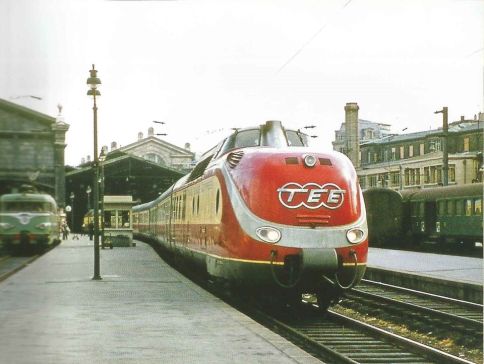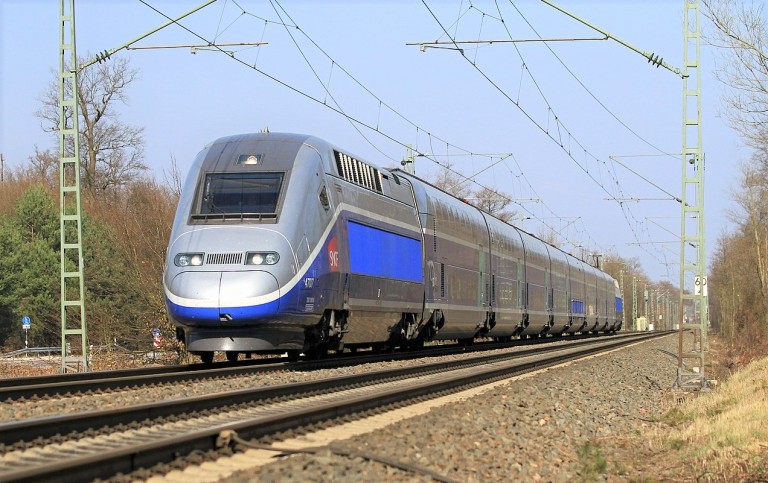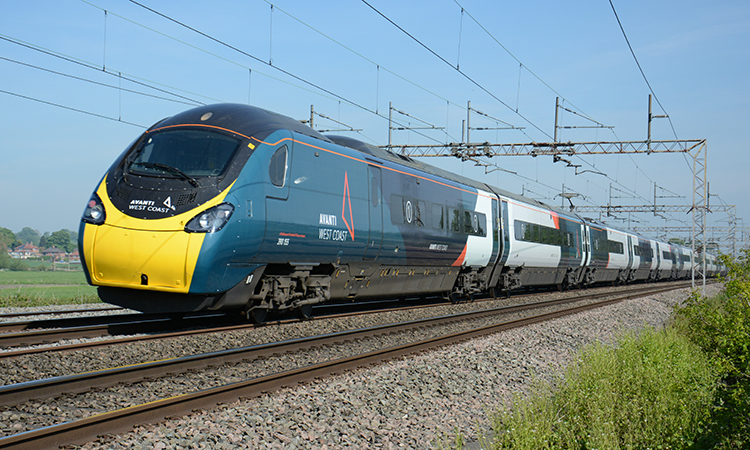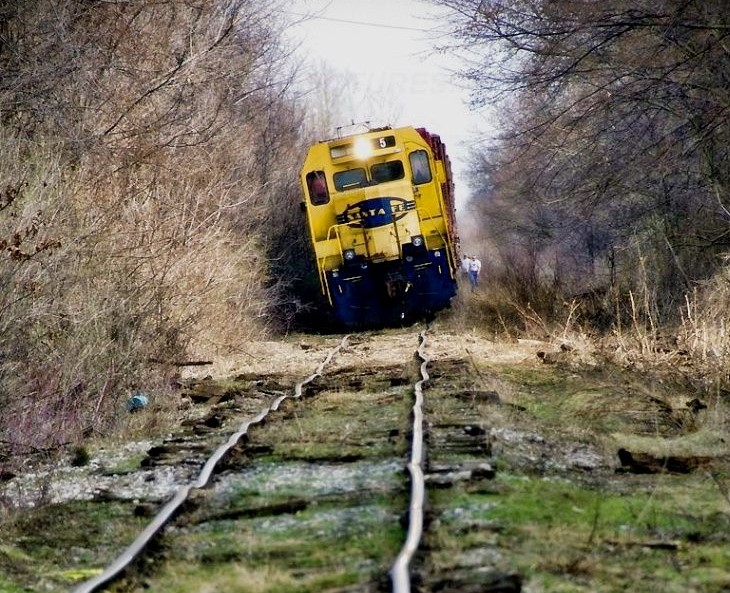05/02/2021 – By Frédéric de Kemmeter – Railway signalling
Suscribe my blog
 (photo Schnitzel Bank via licence flickr)
(photo Schnitzel Bank via licence flickr)
A train every half hour from city to city and from village to village. Convenient transfers without long waiting times, even in the countryside. Riding a train anywhere in the country would be as easy as riding the S-Bahn in the cities today. It is the Deutschlandtakt, the german’s clockface timetable (also called D-Takt). This vision for a new railway age is to become reality in Germany by 2030 – with additional, reliable and fast connections for people and goods by rail. But what does this imply?
Talking about the german’s clockface timetable might seem surprising, as trains have been clocked throughout the country for a long time. Hourly long-distance intercity trains have been one of Germany’s great success stories since 1979. ‘Jede Stunde, Jede Klasse’, every hour in every class, was intended to be the antithesis of the Trans-Europ-Express, a first-class train which only ran once or twice a day. The introduction of Deutsche Bahn’s IC trains coincided with the downgrading of many Trans-Europ-Express trains to Intercity. At regional level, many lines were also gradually converted to clockface timetable. The regionalisation of this segment from 1996 onwards has further accentuated this clockface timetable in the area of the Länder (regional « states »), for example through the Rheinland-Pfalz Takt (Rhineland-Palatinate), the 3-Löwen-Takt in Baden-Württemberg or the NRW Takt. So what is the problem? The problem is that each Land has made its own timetable without taking into account the long-distance Intercity, which has followed its own national logic. As a result, there are sometimes long connection times between an Intercity operated by DB-Fernverkehr and the regional trains now operated by the Länder.
The German idea is to be able to go from everywhere to everywhere every hour or half hour, which requires symmetry of all timetables in the country, both in long-distance and regional traffic and even in buses. The main question that comes to mind is why regional services cannot correctly connect with intercity services. The challenge is to match the symmetry needs of the Länder with the passage of mainline Intercity trains. However, this symmetry is rarely possible. As our example below shows, a Cologne-Stuttgart Intercity may pass at h+12 in the north-south direction, and h+27 in the south-north direction. In this case, each intercity train must be systematically connected to several regional trains:
- a first several trains connecting with the h+12 Intercity (in blue)
- a second several trains connecting with the h+27 Intercity (in green)
Several shortcomings can be seen in this diagram:
- an imbalance with two series of regional trains too close in time. For example: a departure to destination X at h+16 and h+32, and then nothing before the next h+16, i.e. a « gap » of 44 minutes.
- a risk of conflict between h+19 and h+23 with outgoing Y and Z regional trains (in blue) and incoming X and Y regional trains (in green). Do we have enough tracks to cross all trains at the same time?
- the station is no longer active between h+40 and the following hour h+02, i.e. 22 minutes.
The idea is that the two Intercity trains should meet at the same time in the main station, so that only one set of regional trains needs to be connected, e.g. at h+12 and h+13 for the two Cologne-Stuttgart Intercity trains.
However, what is possible at one station becomes a problem at other major Intercity stations, as the following diagram shows:
The diagram shows that if we have perfect symmetry at station B, the journey times are such that we end up with poor symmetry at stations A and C. We find here the famous Swiss idea of « to go as fast as necessary ». The solution is that the journey times between major stations should all be 30 or 60 minutes. In the case of our scheme, this would mean:
- between A and B, the journey time is extended from 54 to 60 minutes;
- between B and C, the journey time would be shortened from 37 to 30 minutes, with extensive work.
In this way, a good symmetry is achieved in the three stations A, B and C:
But we should reassure you: Deutsche Bahn does not plan to lengthen some intercity travel times to « optimize » the symmetry in each major station. Instead, it aims to reduce journey times, as this April 2021 document shows:
 (Schema Deutschland-Takt – Click to enlarge)
(Schema Deutschland-Takt – Click to enlarge)However, the developers of this theory soon realised that it was a huge task to implement this symmetry on the scale of a country like Germany. The whole problem with symmetry, not only in Germany but throughout Europe, is that it is infrastructure and geography that dictate travel times. Not every city can be connected by 30- or 60-minute blocks, because the speed allowed depends on distance between cities, curves, capacities of the network and many other parameters such as signalling system. The amount of work required to achieve this is precisely what has been debated for several years.
The Austrians have also tried the same exercise and the theorical result is this configuration in which the large and medium-sized stations have a symmetrical timetable if the journey times are all identical in quarter-hour blocks:
 (Schema FVV TU Wien 2016 – Klaus Garstenauer – Click to enlarge)
(Schema FVV TU Wien 2016 – Klaus Garstenauer – Click to enlarge)In practice, it can be seen, for example, that all Railjets (in red) arrive and depart from Linz, Wels and Attnang-Puchheim stations in symmetrical blocks in both directions, allowing half-hourly connections from each of these cities. It is likely that the « generous » geography of the locations helped to achieve such symmetry. This is not feasible everywhere:
 (Schema FVV TU Wien 2016 – Klaus Garstenauer – Click to enlarge)
(Schema FVV TU Wien 2016 – Klaus Garstenauer – Click to enlarge)It is also necessary to convince each Land, which has control over regional timetables, to align itself with the Intercity trains, if they are guaranteed symmetry on an hourly or half-hourly basis on each regional line. This is not a foregone conclusion. The Länder pay for their regional trains and are very much involved in the railway policy they pursue for their constituents. They are not specifically attached to Deutsche Bahn even though DB Regio still holds two-thirds of the public service contracts. Some Länder have replied that they do not see the need for such alignment on Intercity scheme because, they say, most of their customers do not use Intercity but travel locally, for example daily school traffic. It will also be necessary to justify to them that at a given location, track straightening or train acceleration work will require several million euros of work, which will undoubtedly agitate residents and may even, in some cases, limit local train traffic during the work period. As we can see, the general national interest is likely to clash with the general regional interest…
A proposal for a German national Takt based on the Swiss approach were first made in 2008 by several industry experts. Within the framework of the Zukunftsbündnis Schiene (Alliance for the Future of Rail), the consultancy office SMA presented an expert draft for the timetable Deutschland-Takt at the Federal Ministry of Transport (BMVI) in Berlin on 9 October 2018. This milestone was preceded by several interim drafts, consultations with the federal states and with the BMVI in order to combine the requirements of all stakeholders into a nationwide overall concept for passenger and freight transport.
 New railway line of Koralm Bahn, in Austria. These large-scale works could sometimes be necessary to reduce the time between two cities from 34 to 30 minutes (photo Koralm Bahn)
New railway line of Koralm Bahn, in Austria. These large-scale works could sometimes be necessary to reduce the time between two cities from 34 to 30 minutes (photo Koralm Bahn)
The work and the results have been given additional impetus by the fact that the Federal Ministry of Transport has launched the Rail Alliance of the Future, which bundles the interests and gives new weight to the voices of the railway industry. The D-Takt focuses on the timetable and derives from it the necessary infrastructure measures to create the best symmetry as mentioned above. The work has continued in 2019 with the preparation of a second expert draft based on the feedback on the first draft. An update version was providing in June 2020 although the final plan and infrastructure works to enable it are bound still to change in the 20+ years.
The motto of the D-Takt programme is now ‘first the timetable, then the infrastructure planning’, which is the opposite of what was done in the past. As told Today’s Railway, the future D-Takt is used as the basis for national network-wide capacity-driven planning although actual delivery of new infrastructure will depend upon planning timescales and the availability of funds as the current committed sums are insufficient. In March 2020 the German Parliament passed the Massnahmengesetzvorbereitungsgesetz (MgvG), which roughly translates as the nondescript « Measures Act Preparation Act ». While it includes some projects required for D-Takt it does not include all of them and only seven of the 12 nominated projects are rail infrastructure.
Some routes have already been decided and, in addition, 7 routes seem to be planned for private operators. But many questions remain as to how this giant mikado will be implemented and what the place of private operators and rail freight will be and what works are planned. See you next week for the answer to these questions. Stay tuned…
>>> Continue to our second part
Other related articles:
 The Trans-Europ-Express explained for Millennials
The Trans-Europ-Express explained for Millennials
04/18/2021 – This has been the big buzz in recent months since the German transport minister presented his TEE 2.0 concept in autumn 2020, which includes night trains and a host of other things. It is an opportunity to remind millennials what the TEE concept once was, that night trains had nothing to do with it, and why it’s all changed since the 2000s. But what was really the TEE?
 Why are Japanese trains so punctual?
Why are Japanese trains so punctual?
– 03/22/2020 – Railroads in Japan go back 140 years. Over this time, an impressive amount of know-how has been accumulated to ensure a smooth-running railways. This helped to design a system which today is considered to be one of the best in the world. But why is that and how do they do it? Explanations.
 How Alstom wants to force mainline competition in Germany
How Alstom wants to force mainline competition in Germany
02/22/2021 – DB has very little competition in the mainline segment and mainly opts for the same supplier. However, a manufacturer would like to change this in order to shake up the homeland of Siemens.
 The productive use of rail travel: what ask customers?
The productive use of rail travel: what ask customers?
03/08/2021 – How can we make the rail journey more timely? There is still a lot of work to be done, but rail has some arguments to achieve this.
 What has the liberalization of the european railways brought?
What has the liberalization of the european railways brought?
01/11/2021 – The liberalisation of the railways is still something that is poorly explained, leading to various slogans and beliefs. Here we try to look around the issue
 Sustainable railways mean infrastructure works !
Sustainable railways mean infrastructure works !
11/16/2020 – 2021 has been designated European Year of Rail. This means not only modern trains but also good railway infrastructures. Some people believe that this is not always necessary. Really?






Vous devez être connecté pour poster un commentaire.